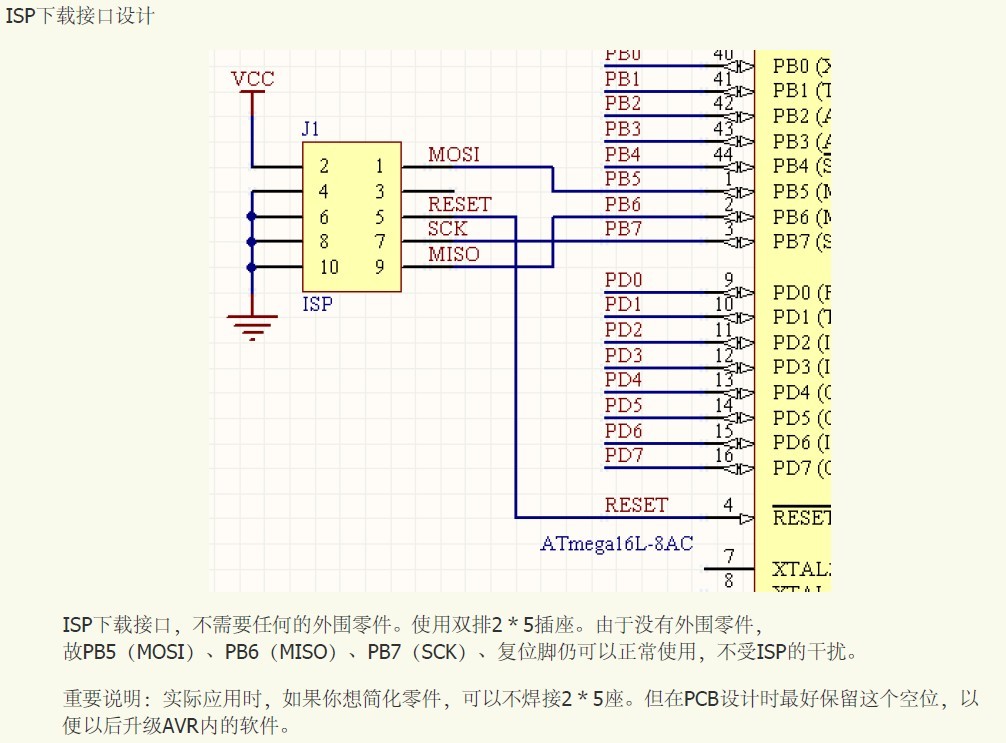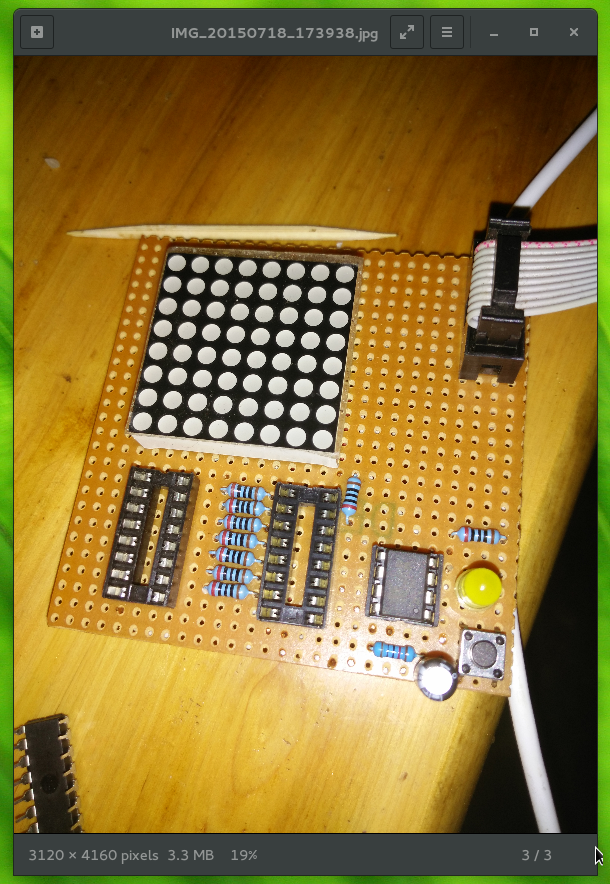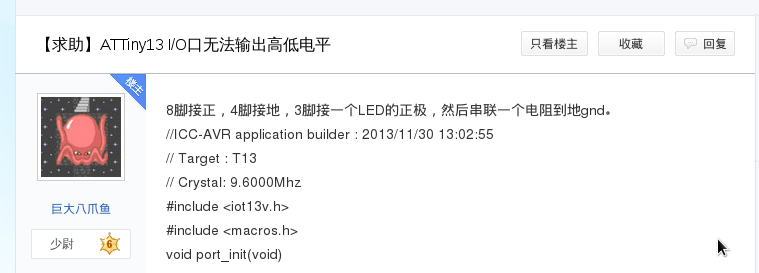|
[使用方法]ATtiny13A芯片的使用方法 |
 一派掌门 二十级 |
首先,祝贺我成功地点亮了LED灯!  |
 一派掌门 二十级 |
 电路: 第1脚接正常的AVR RESET电路,和ATMega16一样,电容10μF。 第3脚通过一个200欧姆的电阻接发光二极管的正极。 然后按照ATMega16的电路图接上ISP下载口。 
|
|
 一派掌门 二十级 |
 如图,插好USBASP。图中的两个HC595和一个8x8LED不用管,我以前就焊好了。
|
|
 一派掌门 二十级 |
然后编写一个C文件,文件名tiny.c:
#include <avr/io.h>
#include <avr/eeprom.h>
int main()
{
DDRB |= _BV(4); //把PB4设置为输出
PORTB |= _BV(4); //把PB4设置为高电平
eeprom_busy_wait();
eeprom_write_byte(0x00, 0xa5);
eeprom_busy_wait();
eeprom_write_byte(0x01, 0xb6);
eeprom_busy_wait();
eeprom_write_byte(0x02, 0xc7);
eeprom_busy_wait();
eeprom_write_byte(0x03, PORTB);
eeprom_busy_wait();
eeprom_write_byte(0x04, DDRB);
eeprom_busy_wait();
eeprom_write_byte(0x05, PINB);
eeprom_busy_wait();
while (1);
}
为了方便起见,笔者是在Linux下用的avrdude+gccavr进行编译的程序。在Windows平台上和WinAVR等价。用ICC AVR的话就得把头文件改了,还要把_BV改成BIT。
|
|
 一派掌门 二十级 |
Makefile:
# make
tiny.hex: tiny.c
avr-gcc -mmcu=attiny13 -Wall -Os tiny.c -o tiny.o
avr-objcopy -j .text -j .data -O ihex tiny.o tiny.hex
# make run
run: tiny.hex
sudo avrdude -p t13 -c usbasp -e -U flash:w:tiny.hex
|
|
 一派掌门 二十级 |
在终端中执行make run(也可以先make后make run),把程序下载到芯片中。程序的运行结果是:LED亮了!  |
|
 一派掌门 二十级 |
同时,程序运行后获得的EEPROM内容如下:  这说明, PORTB = 0x10 (00010000) DDRB = 0X10 (00010000) PINB = 0x18 (00011000) |
|
 一派掌门 二十级 |
PORTB = 0x10 (00010000)
左边第一位是PB7(当然ATtiny13根本没这个端口)
左边第4位就是PB4,PORTB中只有这一位为1
右边最后一位是PB0
|
|
 一派掌门 二十级 |
现在删掉EEPROM部分的代码。
#include <avr/io.h>
int main()
{
DDRB |= _BV(4); //把PB4设置为输出
PORTB |= _BV(4); //把PB4设置为高电平
while (1);
}
程序运行结果:LED亮
#include <avr/io.h>
int main()
{
DDRB |= _BV(4); //把PB4设置为输出
PORTB &= ~_BV(4); //把PB4设置为低电平
while (1);
}
程序运行结果:LED灭
|
|
 一派掌门 二十级 |
令我奇怪的是,之前不能运行的以下程序:
#include <avr/io.h>
int main()
{
DDRB = 0xff;
PORTB = 0xff;
while (1) {
PORTB = 0xff;
}
}
现在居然又能正常运行了。。。我靠!所以这个原因暂时还没找到。。。
|
|
 一派掌门 二十级 |
闪烁灯程序,本人已证明该程序可以在ATtiny13A上正常运行。
#include <avr/io.h>
#define F_CPU 1000000U // 这个我是暂时乱写的晶振大小,我也不知道现在晶振大小是多少!!!!
#include <util/delay.h>
int main()
{
DDRB = 0xff;
PORTB = 0xff;
while (1) {
PORTB = 0xff;
_delay_ms(1000);
PORTB = 0x00;
_delay_ms(1000);
}
}
|
|
 一派掌门 二十级 |
 我的熔丝位被设置成了2A FF。因为CKSEL = 10,所以芯片是使用的内部的9.6 MHz晶振,又因为CKDIV8 = 0,所以晶振进行了8分频,因为9.6÷8=1.2,所以F_CPU应该被设置为1200000U: #define F_CPU 1200000U
|
|
 一派掌门 二十级 |
插上一个74HC595后,用Linux下的avrdude烧写的以下程序:
#include <avr/io.h>
#define F_CPU 1200000U
#include <util/delay.h>
int main()
{
DDRB = 0xff;
PORTB = 0xff;
while (1) {
PORTB = 0xff;
_delay_ms(500);
PORTB = 0x00;
_delay_ms(500);
}
}
可以正常运行。运行结果:LED亮0.5s灭0.5s。
但是,用AVR_frighter保存flash内容,擦除芯片,重新烧写保存的flash内容后,程序完全不能运行,LED完全不亮。
不过,用AVR_frighter读写熔丝位还是可以的。
|
|
 一派掌门 二十级 |
这充分表明了:
我的推测1“因为ATtiny13的PB口不足8个I/O口,执行DDRB = PORTB = 0xff把全部8个I/O口都设置为1会引起程序故障而导致所有I/O口都不能输出任何电平。必须要执行DDRB |= _BV(4)单独设置一个I/O口为输出,程序才能正常运行” 是 错误的!
我的推测2“74HC595芯片影响了AVR_frighter对ISP程序下载的操作导致程序不能正常下载,而该芯片不影响avrdude下载程序” 可能是正确的。
|
|
 一派掌门 二十级 |
现在通过实验证明推测2的正确性。
在ICC AVR中编写以下程序,并用AVR_frighter烧写:
#include <iot13Av.h> // ATtiny13A
void main(void)
{
DDRB = 0xff;
PORTB = 0xff;
while (1) {
PORTB = 0xff;
}
}
程序运行结果:LED灯不亮。
把PORTB = 0xff;改成PORTB = 0x00;
再编译,烧写,LED灯仍然不亮!!!
这TMD还真是AVR_frighter的问题!
|
|
 一派掌门 二十级 |
现在,马上用Linux下的avrdude重新烧写程序:
[octopus@pc3 ATTiny13]$ make run
avr-gcc -mmcu=attiny13 -Wall -Os tiny.c -o tiny.o
tiny.c:5:6: warning: return type of 'main' is not 'int' [-Wmain]
void main()
^
avr-objcopy -j .text -j .data -O ihex tiny.o tiny.hex
sudo avrdude -p t13 -c usbasp -e -U flash:w:tiny.hex
[sudo] password for octopus:
avrdude: warning: cannot set sck period. please check for usbasp firmware update.
avrdude: AVR device initialized and ready to accept instructions
Reading | ################################################## | 100% 0.02s
avrdude: Device signature = 0x1e9007
avrdude: erasing chip
avrdude: warning: cannot set sck period. please check for usbasp firmware update.
avrdude: reading input file "tiny.hex"
avrdude: input file tiny.hex auto detected as Intel Hex
avrdude: writing flash (86 bytes):
Writing | ################################################## | 100% 0.76s
avrdude: 86 bytes of flash written
avrdude: verifying flash memory against tiny.hex:
avrdude: load data flash data from input file tiny.hex:
avrdude: input file tiny.hex auto detected as Intel Hex
avrdude: input file tiny.hex contains 86 bytes
avrdude: reading on-chip flash data:
Reading | ################################################## | 100% 0.58s
avrdude: verifying ...
avrdude: 86 bytes of flash verified
avrdude: safemode: Fuses OK (E:FF, H:FF, L:2A)
avrdude done. Thank you.
[octopus@pc3 ATTiny13]$
程序正常运行!
(那个int main()写错了暂时不管了。。。)
|
|
 一派掌门 二十级 |
笔者又把ICC AVR生成的hex文件复制到Linux下用avrdude烧写,LED亮了!程序正常运行。
|
|
 一派掌门 二十级 |
所以,ATtiny13A芯片本身没有什么问题。我的电路也没有问题。问题主要出在AVR_frighter上,都怪它!以后不要再用AVR_frighter烧写ATtiny13的程序了!
AVR_frighter烧写gccavr和ICC AVR的程序都无法正常运行。
而Linux下的avrdude烧写gccavr和ICC AVR的程序都可以正常运行。
至于Windows平台下的WinAVR,因为用的编译器和linux下是相同的,所以我估计烧写后也可以正常运行。不过我还没有测试额。。。。
|
|
 一派掌门 二十级 |
笔者又把74HC595取下来了。然后再用AVR_frighter烧写ICCAVR程序,LED不亮。再用avrdude烧写同一个hex文件(ICCAVR生成),LED亮。这证明:
不是74HC595芯片影响了AVR_frighter烧写程序。是AVR_frighter压根就没法正确地烧写ATtiny13芯片!
|
|
 一派掌门 二十级 |
另外,4~13楼的程序中所有的int main()都改为void main(void),笔者疏忽了,不过也不影响程序的编写。
|
|
 一派掌门 二十级 |
  时间过了一年半,问题终于解决了。。。。
|
|
 一派掌门 二十级 |
现在事情已经彻底水落石出了。是AVR_frighter本身的问题导致的,它根本无法烧写程序到ATtiny13。至于开头第二次用avrdude烧写程序到芯片后LED灯还不亮的问题,是因为Makefile导致的。是# make run 下面那一行写错了,导致程序文件修改后执行make run时却没有重新编译就直接烧写到了芯片而出错。avrdude是可以正常烧写ATtiny13的。
|
|
 一派掌门 二十级 |
avrdude烧写程序后也可以在控制台看到熔丝位的值:
avrdude: safemode: Fuses OK (E:FF, H:FF, L:2A)
avrdude done. Thank you.
[octopus@pc3 ATTiny13]$
|
|